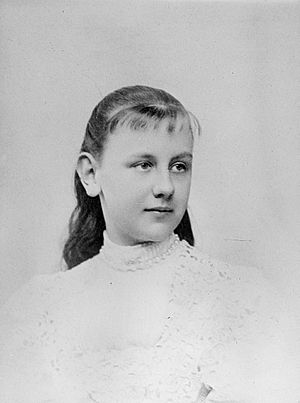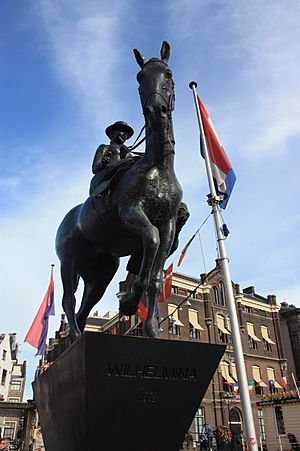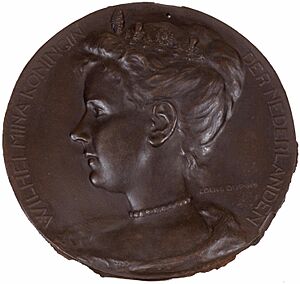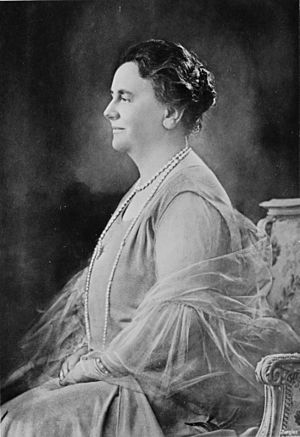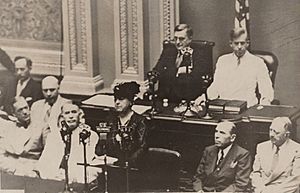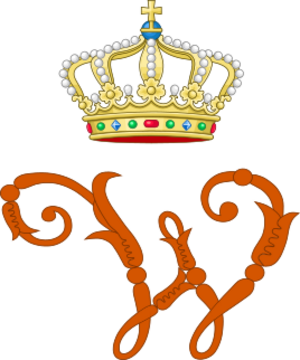Wilhelmina of the Netherlands facts for kids
Quick facts for kids Wilhelmina |
|||||
|---|---|---|---|---|---|
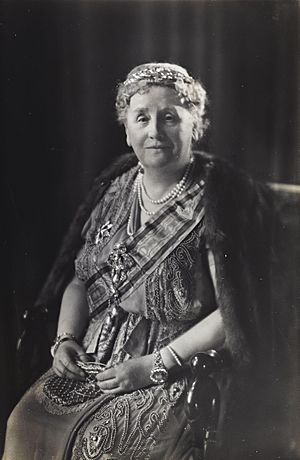
Queen Wilhelmina in the late 1940s
|
|||||
| Queen of the Netherlands | |||||
| Reign | 23 November 1890 – 4 September 1948 |
||||
| Inauguration | 6 September 1898 | ||||
| Predecessor | William III | ||||
| Successor | Juliana | ||||
| Regents | Queen Emma (1890–1898) Princess Juliana (1947–1948) |
||||
| Born | Princess Pauline of Orange-Nassau 31 August 1880 Noordeinde Palace, The Hague, Netherlands |
||||
| Died | 28 November 1962 (aged 82) Het Loo Palace, Apeldoorn, Netherlands |
||||
| Burial | 8 December 1962 Nieuwe Kerk, Delft, Netherlands |
||||
| Spouse |
Henry of Mecklenburg-Schwerin
(m. 1901; died 1934) |
||||
| Issue | Juliana of the Netherlands | ||||
|
|||||
| House | Orange-Nassau | ||||
| Father | William III of the Netherlands | ||||
| Mother | Emma of Waldeck and Pyrmont | ||||
| Religion | Dutch Reformed Church | ||||
| Signature | |||||
Wilhelmina (born Wilhelmina Helena Pauline Maria; 31 August 1880 – 28 November 1962) was the Queen of the Netherlands for almost 58 years. She reigned from 1890 until she stepped down in 1948. Her time as queen was longer than any other Dutch monarch. During her reign, the world saw major events like World War I, the economic crisis of 1933, and World War II.
Wilhelmina was the only child of King William III of the Netherlands and Emma of Waldeck and Pyrmont. She became queen at just 10 years old in 1890 after her father passed away. Her mother, Queen Emma, acted as regent, meaning she ruled until Wilhelmina was old enough. Once Wilhelmina took full charge, she became very popular. She kept the Netherlands neutral during World War I. She also helped solve many of her country's industrial problems. Her smart business choices made her one of the richest women in the world. She also made sure her family, the House of Orange-Nassau, remained one of the few royal families still in power in Europe.
When Germany invaded the Netherlands in 1940, Wilhelmina had to leave for Britain. From there, she led the Dutch government-in-exile. She often spoke to her people on the radio. She became a strong symbol of the Dutch resistance against the German occupation. By 1948, she returned to a free Netherlands. She was the only one left of the 16 monarchs who were ruling when she first became queen. As her health declined, Wilhelmina stepped down in September 1948. Her daughter Juliana became the new queen. Wilhelmina then retired to Het Loo Palace, where she passed away in 1962.
She is still well-liked in the Netherlands today. Many people see her as a hero of the Dutch resistance during World War II.
Contents
Early Life of Queen Wilhelmina
Wilhelmina Helena Pauline Maria was born on 31 August 1880. Her birthplace was Noordeinde Palace in The Hague, Netherlands. She was the only child of King William III and Emma of Waldeck and Pyrmont. Wilhelmina had a very close bond with her parents, especially her father. He was 63 years old when she was born. In her book, Lonely But Not Alone, Wilhelmina remembered her father riding horses.
At birth, Wilhelmina was third in line to the throne. This was due to the "Semi-Salic" system of inheritance. This system meant that sons were preferred over daughters for the throne. Her father had three sons from his first marriage. But two of them had died before Wilhelmina was born. The only other male relatives in the royal family were her father's uncle, Frederick, and his third son, Alexander. Both of them also passed away when Wilhelmina was very young. By 1887, King William III was 70 years old. He decided that Wilhelmina, his only living child, would inherit the throne.
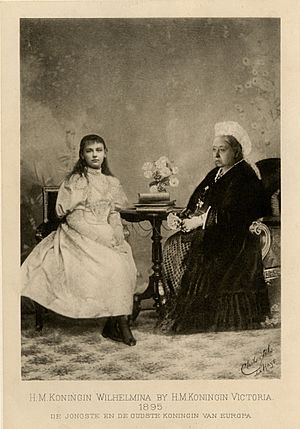
King William III died on 23 November 1890. Wilhelmina was only 10 years old when she became Queen of the Netherlands. Her mother, Queen Emma, became the regent. This meant Queen Emma ruled the country until Wilhelmina was old enough to take over. In 1895, Wilhelmina visited Queen Victoria of the United Kingdom. Queen Victoria wrote in her diary that Wilhelmina was "very slight & graceful" and "very intelligent & a charming child." She also noted that Wilhelmina spoke English very well.
On 6 September 1898, Wilhelmina was officially sworn in as queen. This ceremony took place at the Nieuwe Kerk in Amsterdam. She was a strong-willed woman who spoke her mind. She did not always agree with politicians. Instead, she said she loved the people of her country. Wilhelmina did not like how the British took over the Transvaal Republic and the Orange Free State. This happened during the Second Boer War. The Boers were descendants of Dutch settlers. So, the Dutch people, including Wilhelmina, felt a strong connection to them. During the war, Wilhelmina even sent a Dutch ship to help Paul Kruger, the president of the South African Republic, escape.
Queen Wilhelmina's Marriage
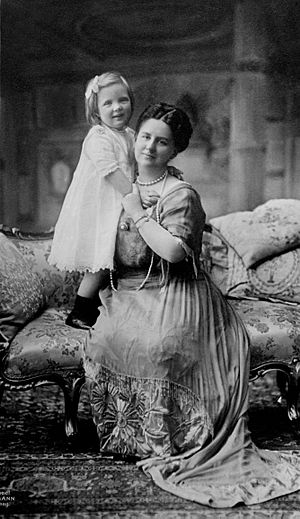
On 7 February 1901, Queen Wilhelmina married Duke Henry of Mecklenburg-Schwerin in The Hague. At first, she was very dedicated to her husband. However, their marriage became unhappy over time. Its main purpose was to have an heir to the throne. Prince Henry was known to have had other relationships outside of their marriage. Some of these relationships resulted in children.
Nine months after her wedding, Wilhelmina had a miscarriage. In May 1902, she gave birth to a son who was born too early and did not survive. Her next pregnancy also ended in a miscarriage in July 1906. During this time, people worried about who would become queen if Wilhelmina had no children. Her cousin, Prince Heinrich XXXII Reuss of Köstritz, was next in line. He had strong ties to the German royal family and military. People feared that if Wilhelmina remained childless, the Dutch throne might fall under German influence. This could threaten the independence of the Netherlands.
The birth of Princess Juliana on 30 April 1909 brought great relief. This was after eight years of Wilhelmina's marriage without a living child. Juliana and her mother had a very close relationship. Wilhelmina had two more miscarriages in 1912.
Queen Wilhelmina During World War I
Before World War I started, Wilhelmina visited the powerful German Emperor Wilhelm II. The Emperor tried to impress her by saying his guards were very tall. Wilhelmina politely replied, "Quite true, Your Majesty, your guards are seven feet tall. But when we open our dikes, the water is ten feet deep!" This showed her strong will and how she would protect her country. She was very worried about a German attack.
Thanks partly to her influence, the Netherlands stayed neutral during World War I. However, the Allies (Britain, France, and Russia) blocked trade with Germany. They stopped Dutch ships and limited imports to the Netherlands. This was to make sure goods did not reach Germany. Also, the Russian Revolution in 1917 caused the queen to lose a lot of her personal money.
As a woman, Wilhelmina could not be the supreme commander of the army. But she often inspected the Dutch forces without warning. She wanted to see the real situation, not a prepared show. She believed in having a small but well-trained and equipped army. She was often unhappy with her governments for cutting the military budget. In June 1917, Wilhelmina was on a train that crashed near Houten. She was unharmed and helped care for the injured.
After the war, there was some unrest in the Netherlands. A Socialist leader, Pieter Jelles Troelstra, wanted to change the government and monarchy. He hoped to gain control of Parliament with the support of workers. However, Queen Wilhelmina's popularity helped calm the country. She showed strong public support by riding through crowds in an open carriage with her daughter. At the end of World War I, Kaiser Wilhelm fled to the Netherlands. He was given political asylum because of his family ties to the Dutch royals. Wilhelmina stood firm against the Allies who wanted him handed over. She reminded them about the rights of asylum.
Between the World Wars
Wilhelmina was very good at business. She used her family's wealth to invest in the United States. These investments made her one of the richest women in the world. During the 1920s and 1930s, the Netherlands grew as an industrial country. This was partly thanks to the Queen's investments. Engineers also worked on the Zuiderzee Works. This huge project reclaimed vast amounts of land from the sea. Its main goals were to prevent floods and create more land for farming.
In 1939, the government suggested building a refugee camp near Apeldoorn. This camp would be for German Jews fleeing the Nazi regime. However, Wilhelmina stepped in. She felt the location was too close to the royal family's summer home, Het Loo Palace. She worried that spies might be among the refugees. After many talks, the camp was built about 10 kilometers from the village of Westerbork.
Besides economic and security matters, Queen Wilhelmina spent much of the 1930s finding a husband for Juliana. This was hard because Wilhelmina was very religious. She insisted that her daughter's husband be a Protestant and of royal birth. Many possible matches from the United Kingdom and Sweden either said no or were rejected by Juliana. Finally, they found a good match in German Prince Bernhard of Lippe-Biesterfeld. Wilhelmina had her lawyers write a very detailed prenuptial agreement. This document clearly stated what her future son-in-law could and could not do.
Queen Wilhelmina During World War II
On 10 May 1940, Germany invaded the Netherlands. Queen Wilhelmina, nearly 60 years old, and her family had to flee The Hague. They boarded a British destroyer, HMS Hereward, sent by King George VI. They sailed across the North Sea to Britain. There is some discussion about their departure. Some say the evacuation to the UK was planned. Others say the queen intended to go to the Dutch province of Zeeland. But as German forces advanced, Zeeland also became unsafe. This forced the ship to sail for the United Kingdom. She arrived in the UK on 13 May, hoping to return to the Netherlands soon. The Dutch armed forces in the Netherlands surrendered on 15 May.
In Britain, Queen Wilhelmina led the Dutch government-in-exile. She quickly set up a command structure and sent a message to her people. Relations between the new Dutch government and the queen were sometimes difficult. But Wilhelmina became the most important figure. Her experience and knowledge earned her respect from other world leaders. The Dutch prime minister, Dirk Jan de Geer, believed the Allies would not win. He wanted to negotiate peace with Germany. Wilhelmina worked to remove De Geer from power. With help from minister Pieter Gerbrandy, she succeeded.
During the war, Queen Wilhelmina's photograph became a symbol of resistance against the Germans. Like Winston Churchill, Wilhelmina broadcast messages to the Dutch people over Radio Oranje. She called Adolf Hitler "the arch-enemy of mankind." Her late-night broadcasts were eagerly awaited by her people. They had to hide to listen to them illegally.
Queen Wilhelmina visited the United States from June to August 1942. She was a guest of the U.S. government. She visited New York City, Boston, and Albany, New York. In Albany, she attended a celebration for the 300th anniversary of the First Church in Albany (Reformed). This church was founded by Dutch settlers in the 17th century. She spoke to the U.S. Congress on 5 August 1942. She was the first queen to do so. In 1943, Wilhelmina went to Canada. She attended the christening of her new granddaughter, Princess Margriet of the Netherlands, in Ottawa. She stayed with her family for a while before returning to the United Kingdom.
During a German bombing campaign called Operation Steinbock, Queen Wilhelmina was almost killed. A bomb took the lives of several of her guards. It also badly damaged her home near South Mimms in England. In 1944, Wilhelmina became the first woman since the 15th century to be made a member of the Order of the Garter. This was a very high honor. Churchill described her as "the only real man among the governments-in-exile" in London.
In England, Queen Wilhelmina thought about how the Netherlands should be after the war. She wanted a strong government made up of people who had been active in the resistance. She removed De Geer and appointed a new prime minister. When the Netherlands was freed in 1945, the queen was disappointed. The same political groups as before the war took power again. In March 1945, she visited the liberated areas of the southern Netherlands. She received a warm welcome from the people in Walcheren and Eindhoven. On 2 May 1945, she stayed at a small country estate called Anneville. People from Breda and nearby towns came to greet their Queen there. She stayed for over six weeks.
After the war, Queen Wilhelmina wanted to give an award to the Polish Parachute Brigade. This was for their brave actions during Operation Market Garden. She sent a request to the government. However, the Minister of Foreign Affairs, Eelco van Kleffens, disagreed. He thought an award for the Poles might upset relations with the 'Big Three' Allies. He felt it could harm national interests. The Polish Parachute Brigade finally received the Military Order of William on 31 May 2006, 61 years after the operation.
Later Years and Retirement

After World War II ended, Queen Wilhelmina decided not to return to her palace. Instead, she moved into a mansion in The Hague for eight months. She traveled through the countryside to encourage people. Sometimes, she even used a bicycle instead of a car. However, in 1947, the country was still recovering. The nationalist rebellion in the oil-rich Dutch East Indies led to strong criticism of the queen by Dutch business leaders.
Around the same time, Queen Wilhelmina's health began to fail. This forced her to temporarily hand over her duties to Princess Juliana in late 1947. She thought about stepping down permanently. But her daughter urged her to stay for the country's stability. Wilhelmina intended to do so. However, exhaustion forced her to give her duties to Juliana again on 12 May 1948. This left Princess Juliana to deal with early elections caused by the loss of the Indonesian colonies.
Wilhelmina was upset by the return to pre-war politics and the upcoming loss of Indonesia. She stepped down on 4 September 1948. She had reigned for 57 years and 286 days. She passed the crown to Juliana due to her age and illness. After this, she was called "Her Royal Highness Princess Wilhelmina of the Netherlands." The influence of the Dutch monarchy continued to decrease after her reign. However, the country's love for its royal family remained strong.
No longer queen, Wilhelmina retired to Het Loo Palace. She made few public appearances. But when the country was hit by the terrible North Sea flood of 1953, she once again traveled around. She encouraged and motivated the Dutch people. In her last years, she wrote her autobiography. It was called Eenzaam, maar niet alleen (Lonely but Not Alone). In it, she shared her life story and showed her strong religious beliefs.
Wilhelmina passed away from a heart attack at Het Loo Palace on 28 November 1962, at the age of 82. She was buried in the Dutch royal family crypt in the Nieuwe Kerk in Delft on 8 December. She had asked for her funeral to be completely in white. This was to show her belief that earthly death was the start of eternal life.
Titles and Honors
How Queen Wilhelmina Was Addressed
- 31 August 1880 – 21 June 1884: Her Royal Highness Princess Pauline of Orange-Nassau
- 21 June 1884 – 23 November 1890: Her Royal Highness Princess Wilhelmina of Orange-Nassau
- 23 November 1890 – 4 September 1948: Her Majesty Queen Wilhelmina, Queen of the Netherlands, Princess of Orange-Nassau
- 4 September 1948 – 28 November 1962: Her Royal Highness Princess Wilhelmina of the Netherlands
When she became queen and before her marriage, Wilhelmina's full title was: "Wilhelmina, by the Grace of God, Queen of the Netherlands, Princess of Orange-Nassau, Duchess of Limburg, etc." After marrying, she also became a Duchess of Mecklenburg, using her husband's title.
Awards and Recognitions
- Netherlands:
- Grand Master of the Military William Order, 1890; Grand Cross, 4 September 1948
- Grand Master of the Order of the Netherlands Lion, 1890
- Grand Master of the Order of Orange-Nassau, 1890
- Joint Grand Master of the Order of the Gold Lion of Nassau, 1890
- Grand Master of the Order of the House of Orange, 1890
- Founder of the Johanniter Order, 1909
Wilhelmina received no Dutch honors before becoming queen at age ten. She also gave up her position as grand master when she stepped down in 1948. So, she was a Dutch princess and former queen who did not hold a Dutch honor in her personal name. Her daughter, Queen Juliana, then appointed her Grand Cross of the Military William Order. This was the only Dutch honor she ever held personally.
International Honors
- Austro-Hungarian Imperial and Royal Family: Grand Cross of the Order of Elizabeth, 1901
- Belgium:
- Grand Cordon of the Order of Leopold (civil), August 1898
- Croix de Guerre Medal
- Brazil: Grand Cross of the Southern Cross
- Czechoslovakia: Collar of the White Lion, 1929
- Denmark: Knight of the Elephant, 5 September 1922
- Ethiopian Imperial Family: Collar of the Order of Solomon
- Finland: Collar of the White Rose, with Star, 1932
- France: Grand Cross of the Legion of Honour, April 1898
- German Imperial and Royal Family: Dame of the Order of Louise, 1st Division, 30 May 1901
- Mecklenburg Grand Ducal Family: Grand Cross of the Wendish Crown, with Bronze Crown, 7 February 1901
- Oldenburg Grand Ducal Family: Grand Cross of the Order of Duke Peter Friedrich Ludwig
- Greek Royal Family: Grand Cross of the Redeemer
- Guatemala: Grand Cross of the Quetzal
- Japan: Grand Cordon of the Precious Crown, 8 August 1899
- Luxembourg:
- Knight of the Gold Lion of Nassau
- Grand Cross of the Oak Crown
- Military Order of Malta: Dame of Honour and Devotion
- Norway: Grand Cross of St. Olav, with Collar, 15 September 1922
- Persian Imperial Family: Order of the Sun, 1st Class
- Peru: Grand Cross of the Sun of Peru, in Diamonds, 1922
- Poland: Knight of the White Eagle
- Portuguese Royal Family:
- Dame of the Order of Queen Saint Isabel
- Grand Cross of the Sash of the Three Orders, 7 February 1901
- Romanian Royal Family:
- Grand Cross of the Star of Romania
- Grand Collar of the Order of Carol I
- Russian Imperial Family: Grand Cross of St. Catherine
- Siam: Dame of the Order of the Royal House of Chakri, 7 September 1897
- Spanish Royal Family:
- Dame of the Order of Queen Maria Luisa, 22 December 1890
- Dame of the Collar of the Order of Charles III
- Dame of the Collar of the Order of Isabella the Catholic
- Sweden: Member of the Order of the Seraphim, 9 September 1922
- Turkish Imperial Family: Grand Cross of the Order of Charity
- United Kingdom:
- Royal Order of Victoria and Albert, 1st Class, 1898
- Associate Dame Grand Cross of St. John, 19 June 1941
- Stranger Lady of the Garter, 24 September 1944
- Yugoslavian Royal Family: Grand Cross of the White Eagle
Places and Things Named After Wilhelmina
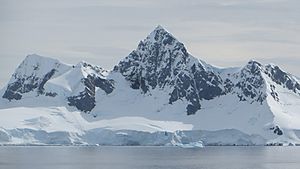
- Queen Wilhelmina State Park in Arkansas and Wilhelmina Bay in Antarctica are named after Queen Wilhelmina.
- In 1892, a company called Fortuin made peppermint candy with the image of the 12-year-old Princess Wilhelmina. These mints are still made today and are known as the "most Dutch of all" sweets.
See also
 In Spanish: Guillermina de los Países Bajos para niños
In Spanish: Guillermina de los Países Bajos para niños


